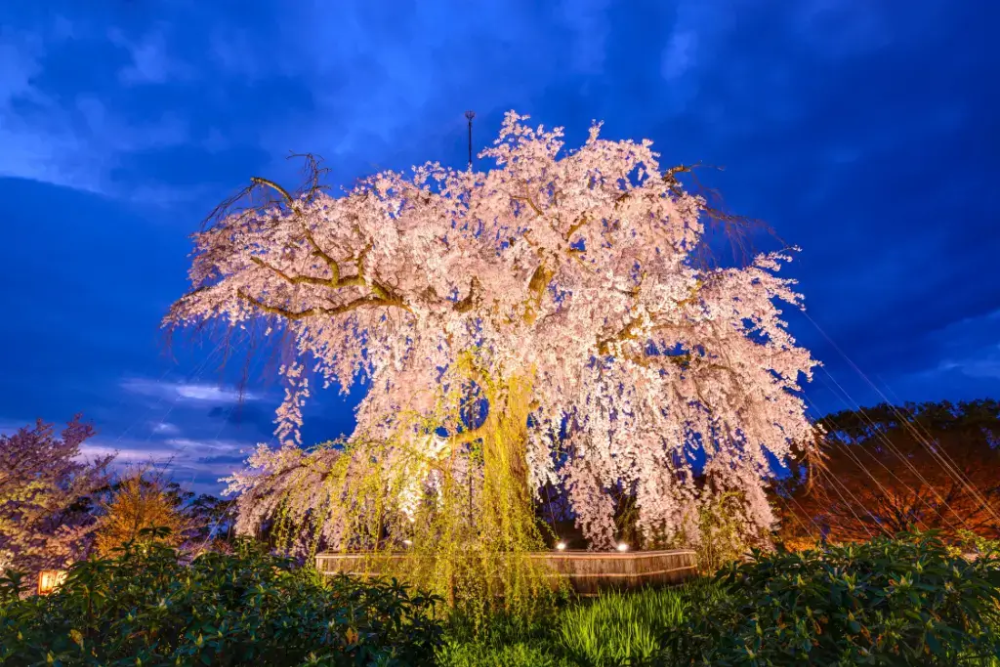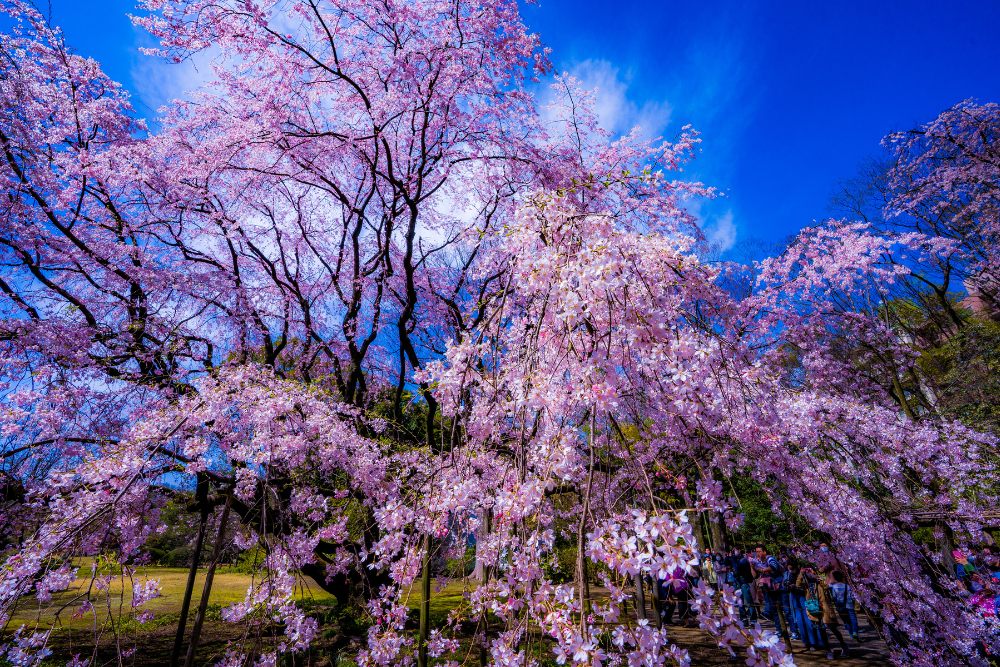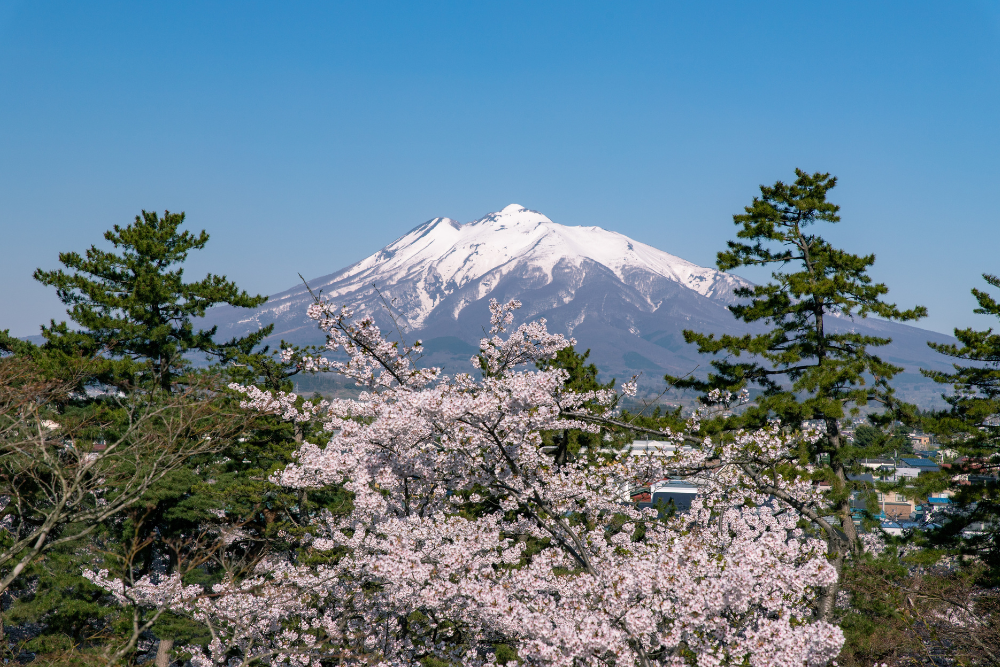Weeping cherry trees, or shidare-zakura (枝垂桜), are among Japan’s most graceful and elegant cherry blossoms. With their cascading branches draped in delicate pink petals, they create an ethereal atmosphere that differs from the typical somei yoshino cherry trees. These blossoms bloom slightly earlier than other sakura varieties, making them a highlight of early hanami season.
In this guide, discover Japan’s most breathtaking locations to view weeping cherry trees in full bloom.
1. Maruyama Park’s Giant Weeping Cherry (Kyoto)
Why visit?
One of Japan’s most iconic weeping cherry trees, the Gion Shidare-zakura in Maruyama Park is an ancient, towering tree that glows beautifully when illuminated at night. Standing alone in the park, its cascading pink petals create a stunning waterfall effect.
Highlights:
- The largest and most famous weeping cherry tree in Kyoto
- Spectacular nighttime illuminations during sakura season
- Close to Yasaka Shrine and Kyoto’s Gion district
Best time to visit: Late March to early April
Access: 10-minute walk from Gion-Shijo Station (Keihan Line)
2. Rikugien Garden (Tokyo)
Why visit?
Rikugien, one of Tokyo’s most beautiful landscape gardens, features a massive weeping cherry tree that stands over 15 meters tall. During peak bloom, this tree is illuminated at night, casting a mystical glow over the traditional garden.
Highlights:
- A historic Edo-period garden with picturesque walking paths
- The famous Shidare-zakura towering over the garden
- A calm and peaceful hanami experience away from crowds
Best time to visit: Late March to early April
Access: 7-minute walk from Komagome Station (JR Yamanote Line)
3. Miharu Takizakura (Fukushima)
Why visit?
Considered one of Japan’s three greatest cherry trees, Miharu Takizakura (meaning “Waterfall Cherry Tree of Miharu”) is an ancient 1,000-year-old weeping sakura that attracts visitors from across Japan. Its sprawling branches extend over 20 meters, creating a breathtaking cascade of pink blossoms.
Highlights:
- One of the oldest and most famous weeping cherry trees in Japan
- The symbol of spring in Fukushima Prefecture
- A must-see for photography enthusiasts
Best time to visit: Mid to late April
Access: 20-minute taxi from JR Miharu Station (Ban’etsu East Line)
4. Daigo-ji Temple (Kyoto)
Why visit?
Daigo-ji, a UNESCO World Heritage Site, is home to some of Kyoto’s most stunning weeping cherry trees. The temple’s vast grounds include a mix of historic pagodas, serene gardens, and breathtaking sakura-lined paths, making it a hidden gem for hanami.
Highlights:
- The Daigo no Hanami Festival, inspired by a famous cherry blossom party held by Toyotomi Hideyoshi
- Multiple weeping cherry trees throughout the temple grounds
- A peaceful atmosphere away from the city crowds
Best time to visit: Late March to early April
Access: 10-minute walk from Daigo Station (Tozai Line)
5. Kajo Park (Yamagata)
Why visit?
Built on the ruins of Yamagata Castle, Kajo Park features hundreds of weeping cherry trees blooming alongside the castle moat. The combination of historic stone walls and cascading pink petals creates a picturesque scene straight out of a samurai-era painting.
Highlights:
- Stunning views of weeping sakura surrounding the castle ruins
- A less crowded alternative to Kyoto and Tokyo hanami spots
- Nighttime illuminations enhance the beauty of the blossoms
Best time to visit: Mid to late April
Access: 10-minute walk from Yamagata Station (JR Yamagata Line)
6. Hirosaki Castle Park (Aomori)
Why visit?
Hirosaki Castle is one of Japan’s top cherry blossom destinations, famous for its weeping cherry trees and late-blooming sakura season. The trees here are strategically planted around the castle’s moat, creating stunning mirror-like reflections in the water.
Highlights:
- Hundreds of weeping cherry trees surrounding the castle
- The famous “sakura raft” effect, where fallen petals cover the moat
- A long sakura season, making it one of the last places to see cherry blossoms in Japan
Best time to visit: Late April to early May
Access: 20-minute bus ride from JR Hirosaki Station
7. Kodaiji Temple (Kyoto)
Why visit?
Kodaiji Temple, located in Kyoto’s Higashiyama district, is home to one of the most elegant weeping cherry trees in Japan, standing in front of a Zen rock garden. This single tree, illuminated at night, is the highlight of the temple’s seasonal light-up event.
Highlights:
- A solitary weeping cherry tree in a traditional Zen setting
- Nighttime illuminations create a mystical hanami experience
- Located near Kyoto’s historic Higashiyama district
Best time to visit: Late March to early April
Access: 10-minute walk from Gion-Shijo Station
8. Shinjuku Gyoen (Tokyo)
Why visit?
Shinjuku Gyoen is home to over 1,000 cherry trees, including several magnificent weeping cherry trees. As one of Tokyo’s largest parks, it offers spacious picnic areas and a variety of sakura species that bloom at different times.
Highlights:
- A mix of early- and late-blooming weeping cherry trees
- A peaceful atmosphere despite being in central Tokyo
- Beautiful Japanese gardens complement the sakura scenery
Best time to visit: Late March to early April
Access: 5-minute walk from Shinjuku-Gyoenmae Station
9. Sengan-en Garden (Kagoshima)
Why visit?
For a southern Japan hanami experience, Sengan-en in Kagoshima offers stunning weeping cherry trees with a view of the active volcano Sakurajima in the background. This historic garden, once owned by the powerful Shimazu clan, is a perfect blend of samurai history and natural beauty.
Highlights:
- Weeping cherry trees blooming with views of Sakurajima Volcano
- A historic Edo-period samurai garden
- Tea houses and samurai residences open for visitors
Best time to visit: Late March to early April
Access: 30-minute bus ride from JR Kagoshima-Chuo Station
Conclusion
Weeping cherry trees offer a more delicate and dramatic hanami experience than typical sakura, with their graceful, cascading branches creating some of Japan’s most stunning spring landscapes. Whether visiting the legendary Miharu Takizakura in Fukushima, the elegant weeping cherry of Maruyama Park, or the serene temple gardens of Kyoto, these trees showcase the most poetic side of Japan’s cherry blossom season.
For the best experience, plan your trip according to bloom times, arrive early to avoid crowds, and explore both daytime and nighttime illuminations for a complete yozakura experience.












